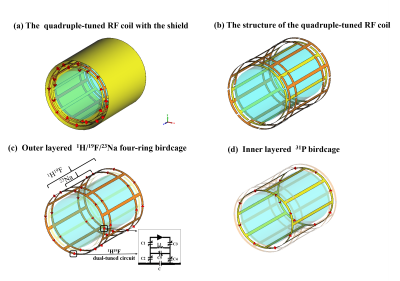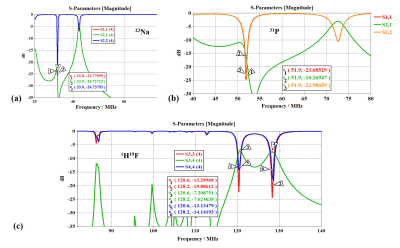3230
Design of a double-layered quadruple-nuclear birdcage coil system for 1H / 19F / 23Na/31P MR imaging at 3T1Lauterbur Imaging Research Center, Shenzhen Institutes of Advanced Technology, Chinese Academy of Sciences, Shenzhen, China, 2Key Laboratory for Magnetic Resonance and Multimodality Imaging of Guangdong Province, Shenzhen, China, 3Department of Biomedical Engineering, State University of New York, Buffalo, NY, United States
Synopsis
The lower natural abundance and gyromagnetic ratios of non-hydrogen nuclei require the use of a highly efficient RF coil to optimize the quality of the MR image and spectroscopy. In this study, a new quadruple-tuned RF coil system capable of 1H / 19F / 23Na /31P imaging was proposed, including the inner high-pass birdcage coil (31P) and a triple-tuned outer four-ring birdcage coil (1H / 19F / 23Na). The feasibility and performance of this proposed RF coil were evaluated and validated by the numerical electromagnetic simulation in the scattering parameters and B1+field distributions.
Introduction
Heteronuclear MR imaging and spectroscopy is significant for attaining morphological and metabolic information in living systems. MRI signals can be acquired from two or more nuclei by using the multiple-nuclear coil in heteronuclear or X-nuclear MRI [1-2]. However, the Inherent physical characteristics including the low concentration and gyromagnetic ratios of X-nuclei require the use of a highly efficient multiple-nuclear coil in order to maximize the signal-to-noise ratio (SNR) [3]. In the design of the multiple-nuclear coil, the close physical proximity of 1H and X-nuclear elements results in strong coupling between them. An efficient coil should simultaneously provide good decoupling and homogenous B1 fields at the resonance frequencies of both (1H) and X-nuclei [4-6].In this study, we designed a novel integrated quadruple-nuclear RF coil system consisting of double-layered 8-leg birdcage coils for 3T MR applications. An outer-layered triple-tuned four-ring birdcage (1H/19F/23Na) and an inner-layered 31P birdcage coils were arranged in the concentric configurations to improve the positioning accuracy and to increase the signal sensitivity of the non-proton nucleus. The feasibility of the proposed quadruple-nuclear coils system and the performance were analyzed by the numerical electromagnetic simulation in the scattering parameters and B1+ field distributions.
Method
The integrated quadruple-nuclear design has been introduced as shown in Fig.1. The constructions involve one high-pass 31P birdcage coil (Fig. 1d) and another triple-tuned (1H/19F/23Na) four-ring birdcage coil (Fig. 1c), the inner-layered 31P coil was placed coaxial inside the outer one and rotated for minimum coupling between the two birdcage coils. For the outer triple-tuned four-ring coil (Fig. 1c), the inner high-pass birdcage operated at 23Na (33.9MHz) corresponding to frequencies at 3T. The outer high-pass structures at each end of the coil in the Fig. 1c were operated at 1H19F (120.6/128.2 MHz) frequencies, which could be achieved by adding the double-tuned circuit in the excited ports of the outer end-rings.The eight leg (1H/19F/23Na/31P) quadruple-nuclear coils system was set with leg and end ring copper width 0.8 cm. The inner rings of the four-ring birdcage were 13 cm apart, and its overall length was 21cm. The outer four-ring birdcage coil with a triple-tuned (1H/19F/23Na) configuration (Fig. 1c) had a diameter of 18 cm. The diameter of the inner high-pass 31P birdcage coil (Fig. 1d) was chose to 16 cm. The distance between the coils and the RF shield was 1 cm.
Numerical simulations and analysis of the triple-tuned four-ring coil system were conducted by Computer Simulation Technology, (Darmstadt, Germany). All lumped elements were represented by 50 Ω discrete ports in the field simulation, which were then replaced by the electron components, and external ports in the circuit co-simulation. Excitation signal sources with phase difference of 90 degrees were selected to generate an ideal circularly polarized/ quadrature mode. We adjusted the values for both inner and outer capacitors until obtained the desired resonance pattern. The ring spacing may be adjusted to control the B1 distribution. The coil was loaded with a cylindrical phantom (14 cm diameter, conductivity σ = 0.8 S/m, permittivity ɛr = 78), the performance the proposed quadruple-nuclear RF coil was evaluated by the S-parameters and B1+ field in the EM simulations. B1+ field maps of the central transverse plane were reconstructed and analyzed.
Results
The double-layered quadruple-nuclear birdcage coil system was able to operate at four frequencies. The inner structure for 23Na mode maybe tuned independently of the coupled outer structures for 1H / 19F mode in the modified triple-tuned outer four-ring birdcage coil. We confirmed the performance of the by measuring the scattering parameters values. The simulation results of the S11 and S21 of the coils were obtained as shown in Fig.2. The results displayed good tuning, matching and decoupling between the channels at 1H / 19F / 23Na/31P frequencies. The simulated B1+ fields of the quadruple-nuclear coils were calculated and shown in the Fig.3. The results indicated the coil system produced a homogeneous B1 field in the center of the transverse plane at 1H / 19F/ 23Na/31P frequencies.Discussion/conclusion
In this study, an eight leg quadruple-nuclear birdcage coil system for 1H / 19F/ 23Na/31P MRI and spectroscopy at 3T was designed. The performance of the coil was evaluated by the numerical simulation in scattering parameters and B1+ field’s distributions. The proposed quadruple-tuned volume coil based on the birdcage coil design is feasible for 3T MR applications. This construction of the proposed coil system can also be applicable for other nucleus. In comparison to the conventional birdcage coils, setting up the outer-layered triple-tuned four-ring coil in tuning and matching requires more iteration due to its complexity in the circuits. In the future work, the performance of the double-layered quadruple-nuclear birdcage coil will be further optimized by adjusted the size and ring spacing, which may be adjusted to control the B1 distribution.Acknowledgements
This work was supported in part NSFC under Grant No. 81627901; National Key R&D Program of China, 2021YFE0204400; the Strategic Priority Research Program of Chinese Academy of Sciences (Grant No. XDB25000000); city grant RCYX20200714114735123.References
[1] Hong S. M, Choi C.H, Magill A. W, et al. Design of a quadrature 1H/31P coil using bent dipole antenna and 4-channel loop at 3T MRI. IEEE Trans.Med. Imag., 2018; 37(12): 2613–2618.
[2] Ha Y.H, Choi. C. H, Shah N.J, et al. Development and Implementation of a PIN-Diode Controlled, Quadrature-Enhanced, Double-Tuned RF Coil for Sodium MRI. IEEE Trans. Med. Imaging. 2018; 37(7): 1626–1631.
[3] Y. Duan, B.S. Peterson, et al. Computational and Experimental Optimization of a Double-Tuned 1H/31P Four-Ring Birdcage Head Coil for MRS at 3T. J. Magn. Reson. Imaging. 2009; 29: 13-22.
[4] T. Lanz , M. V. Kienlin , W. Behr, et al. Double-tuned four-ring birdcage resonators for in vivo 31P-nuclear magnetic resonance spectroscopy at 11.75 T. Magma, 1997, 5(3):243.
[5] C. H. Choi, S. M. Hong, J. Felder, et al. The state-of-the-art and emerging design approaches of double-tuned RF coils for X-nuclei, brain MR imaging and spectroscopy: A review. Magn. Reson Imaging.2020; 72:103-116.
[6] N. Li, X. Yang, F. Du, et al. Simultaneous acquisition of 1H/ 19F/ 23Na/ 31P MR imaging in Phantom at 3T using a quadruple-nuclear RF coil system. ISMRM. 2021; 1790.
Figures


